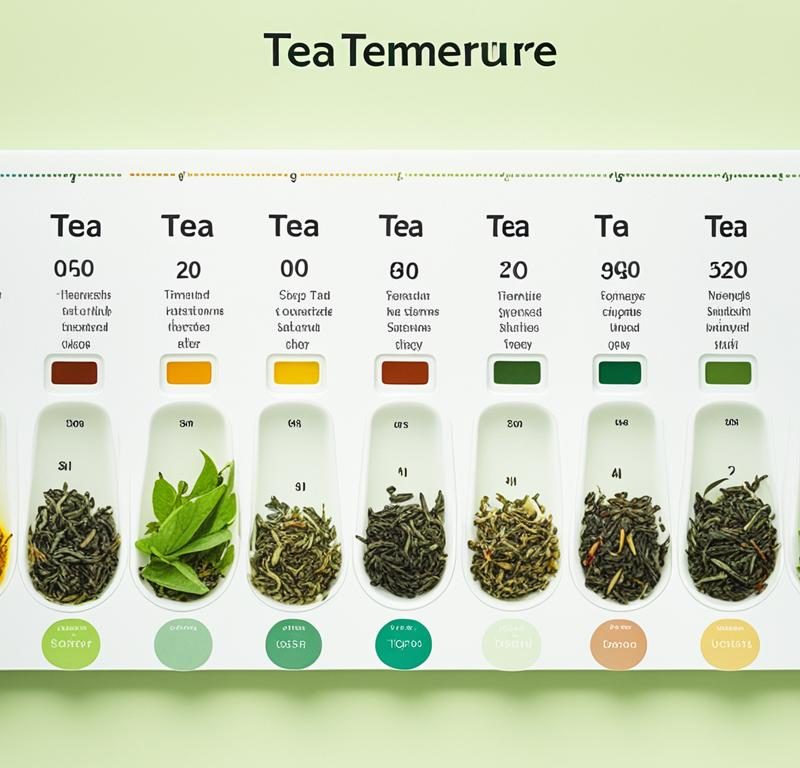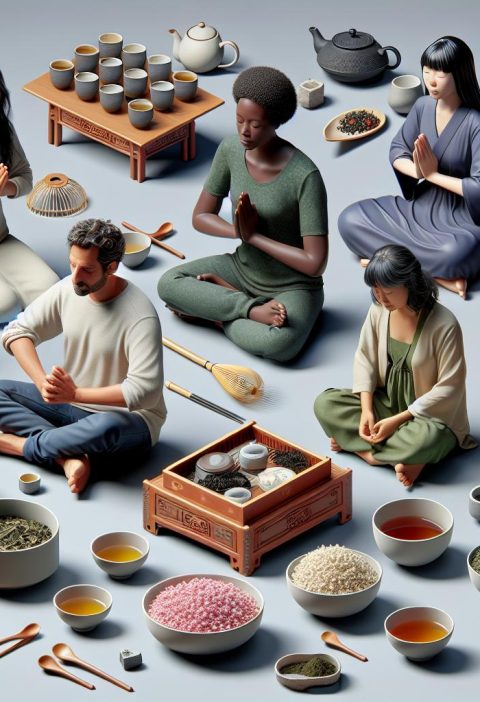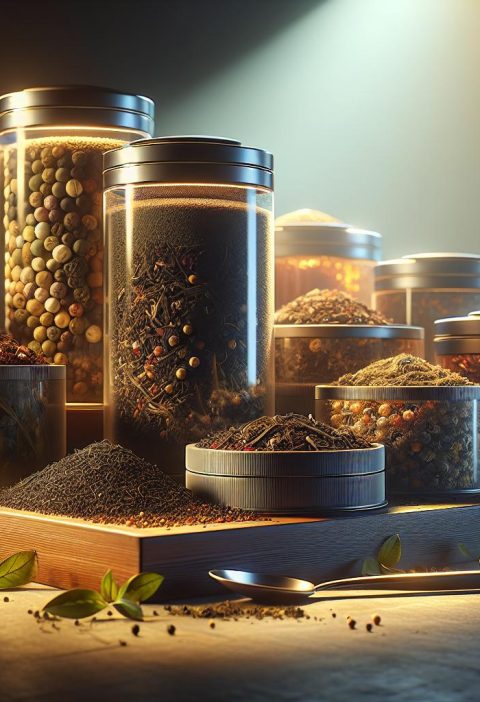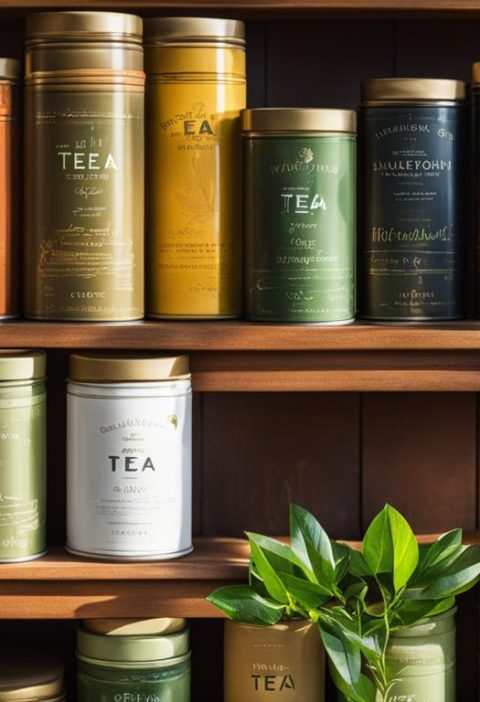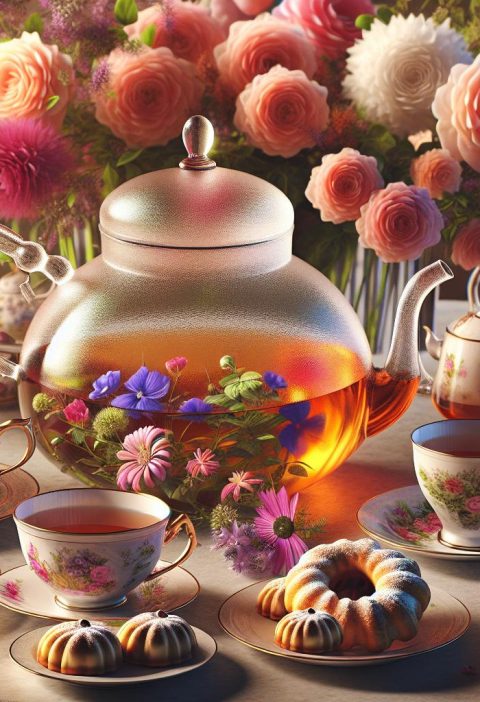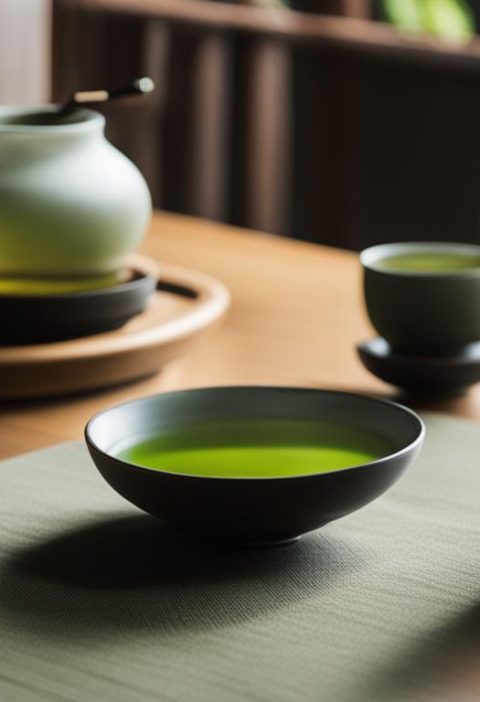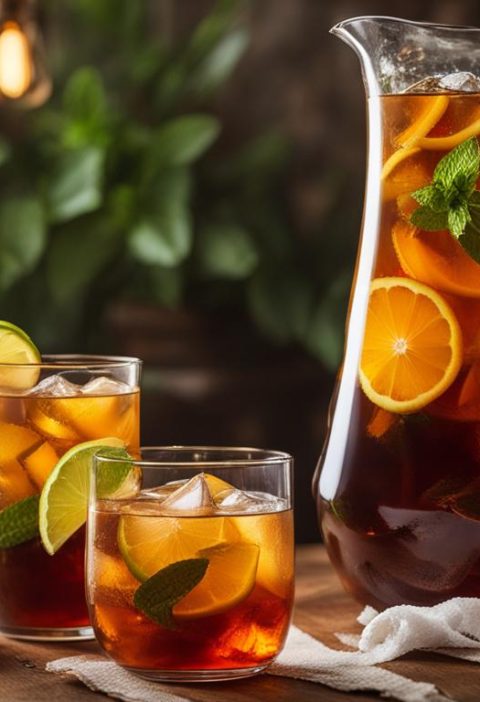When it comes to brewing tea, the steeping temperature plays a crucial role in extracting the best flavors from the tea leaves. Each type of tea has its own ideal steeping temperature, and getting it right can make all the difference in the taste of your cup of tea. Brewing at too high a temperature can result in a bitter and harsh flavor, while brewing at too low a temperature can leave you with a weak and bland cup. In this guide, we will explore the recommended tea steeping temperatures for different types of tea and provide you with tips on how to brew the perfect cup every time.
Recommended Tea Steeping Temperatures
Here is a breakdown of the recommended tea steeping temperatures for different types of tea:
Black Tea
- Recommended Temperature: Full boil (212 degrees Fahrenheit)
- Steeping Time: 3-5 minutes
Green Tea
- Recommended Temperature: 175-180 degrees Fahrenheit
- Steeping Time: 1-3 minutes
White Tea
- Recommended Temperature: 175-180 degrees Fahrenheit
- Steeping Time: 2-3 minutes
Oolong Tea
- Recommended Temperature: 195 degrees Fahrenheit
- Steeping Time: 2-4 minutes
Pu-erh Tea
- Recommended Temperature: Full boil (212 degrees Fahrenheit)
- Steeping Time: 3-5 minutes
Herbal Tea and Rooibos Tea
- Recommended Temperature: Full boil (212 degrees Fahrenheit)
- Steeping Time: 5-7 minutes
Purple Tea
- Recommended Temperature: 175-180 degrees Fahrenheit
- Steeping Time: 2-3 minutes
Mate Tea
- Recommended Temperature: 150-160 degrees Fahrenheit
- Steeping Time: 3-5 minutes
Matcha Tea
- Recommended Temperature: 175 degrees Fahrenheit
- Steeping Time: Whisk vigorously
Why Brewing Temperature Matters
Getting the brewing temperature right is essential for a flavorful and enjoyable cup of tea. The temperature affects the extraction of the tea’s flavor compounds and can impact the balance of bitterness, astringency, and sweetness. By following the recommended temperatures for each tea type, you can unlock the full potential of the tea leaves and create a truly delightful tea-drinking experience.
Key Takeaways:
- Each type of tea requires a specific steeping temperature to achieve optimal flavor.
- Brewing at too high or too low a temperature can result in a less enjoyable cup of tea.
- Investing in an electric tea kettle with a temperature sensor can help you achieve the perfect steeping temperature.
- Using the correct water temperature allows for the extraction of the tea’s unique flavors and characteristics.
- Steeping time is also crucial to avoid over-extraction or under-extraction of the tea leaves.
Recommended Tea Steeping Temperatures
When it comes to brewing the perfect cup of tea, the temperature of the water plays a crucial role. Different types of tea require different water temperatures for optimal flavor extraction. Finding the optimal water temperature for tea can greatly enhance your tea-drinking experience. To help you achieve the perfect brew every time, we have compiled a comprehensive tea temperature chart:
| Tea Type | Recommended Temperature |
|---|---|
| Black Tea | 212°F (100°C) |
| Green Tea | 160-180°F (71-82°C) |
| White Tea | 160-180°F (71-82°C) |
| Oolong Tea | 190-200°F (88-93°C) |
| Herbal Tea | 212°F (100°C) |
| Rooibos Tea | 212°F (100°C) |
| Pu-erh Tea | 212°F (100°C) |
| Purple Tea | 160-180°F (71-82°C) |
| Mate Tea | 150-160°F (66-71°C) |
| Matcha Tea | 160-180°F (71-82°C) |
Note: These are general recommendations, and you may find that slight adjustments in temperature better suit your personal taste. It’s always a good idea to experiment and find the right temperature that brings out the flavors you enjoy most.
By steeping your tea at the optimal temperatures, you can unlock the full range of flavors and aromas that each tea has to offer. Remember, temperature matters, and with this tea temperature chart as your guide, you’ll be well on your way to brewing the perfect cup of tea every time.
How to Prepare Loose Leaf Tea
To brew loose leaf tea at the right temperature, it is recommended to follow these tea brewing tips for a flavorful and satisfying cup of tea.
If you have an electric tea kettle with a temperature sensor, it is the most convenient option for achieving the perfect water temperature. The kettle will automatically heat the water to the desired temperature, taking the guesswork out of the process.
If an electric kettle is not available, you can still brew tea at the right temperature by paying careful attention to the water as it reaches a temperature close to a boil. Heating the water until it produces tiny bubbles or steam without reaching a rolling boil is ideal for most tea types.
It is important to ensure that loose leaf tea has enough room to expand during steeping, allowing for maximum flavor extraction. To achieve this, using a teapot, tea infuser, or tea filter is highly recommended. These utensils provide ample space for the tea leaves to unfurl, resulting in a more robust and flavorful brew.
Each type of tea has its own recommended steeping time. To achieve optimal flavor, it is crucial to adhere to the recommended steep time for each tea variety. Steeping times can range anywhere from 1 to 5 minutes, depending on the type of tea and personal preference.
Loose Leaf Tea Brewing Tips:
- Use an electric tea kettle with a temperature sensor for precise water temperature control.
- If using a regular kettle, heat the water until tiny bubbles or steam appear without reaching a rolling boil.
- Give loose leaf tea room to expand by using a teapot, tea infuser, or tea filter.
- Follow the recommended steeping time for each type of tea.
Tea Brewing Equipment:
Here are some popular tea brewing utensils:
| Utensil | Description |
|---|---|
| Teapot | A vessel designed for steeping and serving tea, available in various sizes and materials. |
| Tea Infuser | A small device that holds loose tea leaves while allowing water to flow through for steeping. |
| Tea Filter | A disposable or reusable bag or pouch specifically designed for containing tea leaves during steeping. |
By following these tea brewing tips and using the right equipment, you can ensure that your loose leaf tea is brewed at the right temperature, allowing for a delightful, aromatic, and satisfying tea experience.
Tea Brewing Temperatures by Tea Type
Different tea types require specific water temperatures for optimal flavor extraction. It’s important to brew each type of tea at the recommended temperature to bring out its unique characteristics. Let’s explore the ideal brewing temperatures for black tea, green tea, and white tea.
Black Tea Temperature
Black tea should be prepared with water at a full boil, which is around 212 degrees Fahrenheit (100 degrees Celsius). The high temperature helps to extract the robust flavors and bold aromas of black tea.
Green Tea Temperature
Green tea, on the other hand, calls for a slightly lower water temperature to preserve its delicate flavors. The optimal brewing temperature for green tea is between 175 to 180 degrees Fahrenheit (80 to 82 degrees Celsius). This temperature range allows the tea leaves to steep without becoming bitter or astringent.
White Tea Temperature
White tea, known for its subtle and nuanced flavors, requires an even lower water temperature for brewing. Aim for a temperature of 175 to 180 degrees Fahrenheit (80 to 82 degrees Celsius) when preparing white tea. This gentle heat allows the delicate white tea leaves to unfurl and release their delicate flavors.
To help you visualize the recommended tea brewing temperatures, here’s a table:
| Tea Type | Optimal Brewing Temperature |
|---|---|
| Black Tea | 212°F (100°C) |
| Green Tea | 175-180°F (80-82°C) |
| White Tea | 175-180°F (80-82°C) |
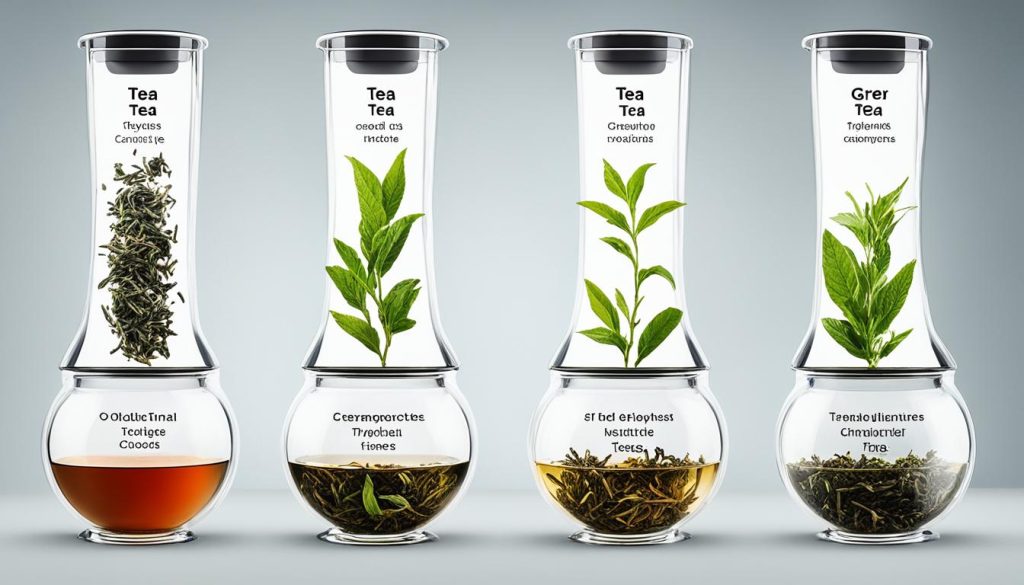
Herbal Tea and Rooibos Tea Temperature
When it comes to preparing herbal teas and rooibos teas, the good news is that you don’t need to fuss over the water temperature. These caffeine-free teas can be steeped using water at a full boil, which is typically around 212 degrees Fahrenheit (100 degrees Celsius). So, no need to carefully measure the temperature or worry about getting it exactly right. Simply wait for the kettle to start boiling, and you’re good to go!
Since herbal teas and rooibos teas are often infused for a longer period of time to extract their unique flavors and beneficial properties, a full boil is perfectly fine. The elevated temperature helps to extract the natural essences from the herbs and botanicals, resulting in a delicious and satisfying cup of tea.
Whether you’re enjoying a calming chamomile blend, a refreshing peppermint infusion, or a soothing rooibos tea, the boiling water will work its magic to unlock the full potential of these delightful caffeine-free beverages.
So go ahead and indulge in the comforting warmth of herbal teas and the earthy goodness of rooibos teas, knowing that the water temperature is one less thing to worry about. Sit back, relax, and savor every sip of your perfectly brewed herbal or rooibos tea.
Specialty Teas Temperature
When it comes to specialty teas like oolong tea and pu-erh tea, the temperature at which they are brewed plays a crucial role in bringing out their unique flavors and characteristics.
Brewing Oolong Tea
Oolong tea, known for its complex taste and aroma, should be brewed with water at around 195 degrees Fahrenheit. This temperature allows the leaves to unfurl gradually and release their exquisite flavors. Steeping oolong tea at a lower temperature may result in a less flavorful cup.
Brewing Pu-erh Tea
Pu-erh tea, a fermented tea with earthy undertones, can be brewed with water at a full boil, which is 212 degrees Fahrenheit. The higher temperature helps extract the rich flavors and creates the full-bodied character that pu-erh tea is known for.
To ensure the best brewing experience, it is recommended to use a thermometer or an electric kettle with temperature control when preparing specialty teas. This allows you to maintain the precise water temperature required for each tea type. Below is a table summarizing the recommended brewing temperatures for oolong tea and pu-erh tea:
| Tea Type | Recommended Brewing Temperature |
|---|---|
| Oolong Tea | 195°F |
| Pu-erh Tea | 212°F |
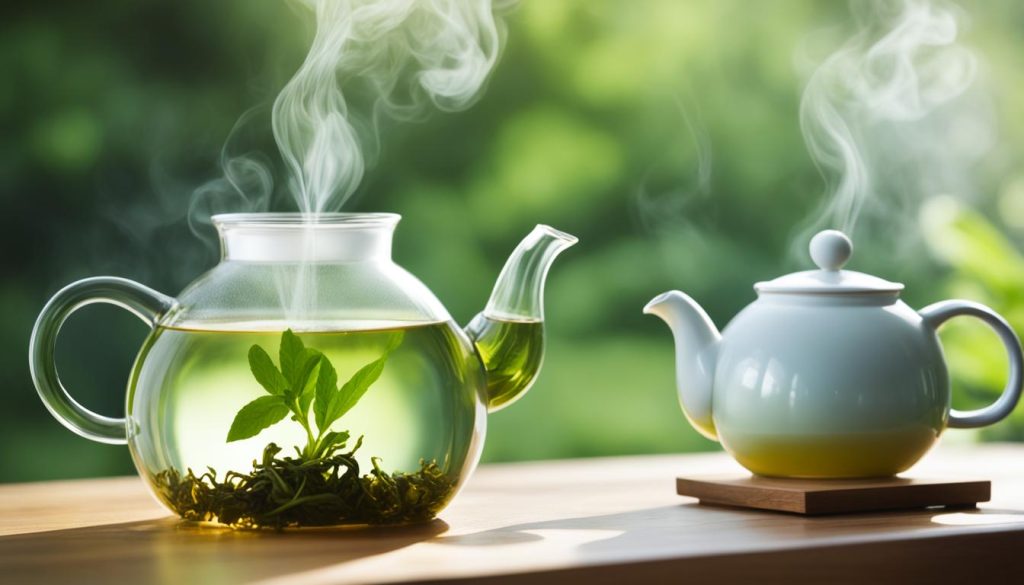
Purple Tea Temperature
Purple tea, a new category of tea known for its high antioxidants and low caffeine content, should be brewed with water at a temperature of 175 to 180 degrees. Found primarily in the Assam region of India and now grown in Kenya, purple tea offers a unique flavor profile that is enhanced by brewing at the recommended temperature.
| Purple Tea | Recommended Brewing Temperature |
|---|---|
| Purple Tea | 175-180 degrees |
Mate Tea Temperature
Mate tea, a stimulating tea native to South America, should be brewed with water at a temperature of approximately 150 to 160 degrees. While not related to the true tea plant, mate tea contains caffeine and offers a unique flavor profile.
- Recommended water temperature for mate tea: 150-160 degrees
- Flavor profile: Unique and stimulating
- Caffeine content: Moderate
When brewing mate tea, it’s important to use water that is hot, but not boiling. Boiling water can result in a bitter taste, while water that is too cool may not extract the full flavor of the tea. By steeping mate tea at the recommended temperature, you can unlock its rich flavor and enjoy a refreshing and invigorating cuppa.
Matcha Tea Temperature
When it comes to enjoying a vibrant cup of matcha, the temperature of the water used for brewing plays a crucial role in achieving the perfect flavor. It is recommended to prepare matcha tea with water at a temperature of about 175 degrees.
Matcha, a powdered green tea from Japan, is known for its vibrant color, unique taste, and numerous health benefits. To fully appreciate its delicate flavors and aromas, it’s essential to use water at the appropriate temperature.
The Importance of the Right Temperature
Water temperature affects the taste and overall experience of matcha. Using water that is too hot can result in a bitter brew, while water that is too cool may lead to a lackluster flavor. Therefore, it’s essential to pay attention to the water temperature when preparing matcha to ensure a harmonious balance of flavors.
How to Achieve the Ideal Temperature
Here are some simple steps to achieve the recommended matcha temperature:
- Bring water to a boil and then let it cool for a few minutes.
- Alternatively, you can use a thermometer to monitor the water temperature until it reaches around 175 degrees.
- Pour the hot water into a bowl or cup.
- Add the desired amount of matcha powder.
- Whisk the mixture vigorously in a zigzag motion until it becomes frothy and well combined.
By following these steps and paying attention to the temperature, you’ll be able to savor the unique flavors and smooth texture that matcha tea has to offer.
| Tea Type | Water Temperature |
|---|---|
| Matcha | 175 degrees |
| Black Tea | 212 degrees |
| Green Tea | 175-180 degrees |
| White Tea | 175-180 degrees |
| Herbal Tea | 212 degrees |
Why Brewing Temperature Matters
Brewing tea at the correct temperature is essential for a flavorful and enjoyable cup of tea. The impact of water temperature on tea flavor cannot be underestimated. When you use water that is too hot, you risk burning the delicate tea leaves and ending up with a bitter cup. On the other hand, if the water is too cool, you’ll have a weak and less flavorful tea.
The benefits of brewing tea at the right temperature go beyond flavor. It also affects the caffeine content in the tea. Higher temperatures release more caffeine, while lower temperatures result in a lower caffeine content. By following the recommended brewing temperatures for each tea type, you can customize your tea experience based on your preferences: a milder cup for a more relaxed feeling or a stronger one for an energy boost.
Whether you’re brewing black tea, green tea, or specialty teas like oolong or pu-erh, understanding the impact of water temperature is key. Each tea type has its own ideal brewing temperature to unlock its unique flavors and characteristics. By paying attention to the water temperature, you can ensure that you’re getting the most out of your tea leaves and enjoying a perfect cup of tea every time.
